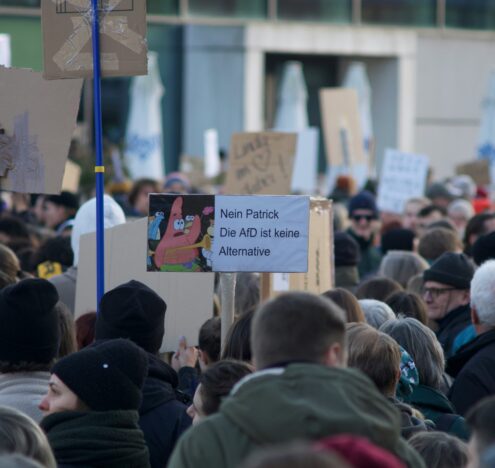BLUF: Gas prices in the US are at an all-time high, but are not the result of one pandemic, war, or president. Instead, massive fluctuations in oil demand from COVID-19 converged perfectly with rising inflation costs and the Russian invasion of Ukraine, all of which is reverberating across the global commodity market, resulting in sticker shock at the pump. The current administration is working overtime to lower those prices but Americans should anticipate a hit on their wallets for a while.
As war rages on in Ukraine, US pumps have seen gas prices skyrocket. Americans without electric or hybrid cars have bemoaned filling their tanks, paying between $3 and an even $5 a gallon. The memes have ensued but the gut punch that has continued to be felt by families across the country has been no joke. Closing out March and heading into the month of Earth Day, President Joe Biden announced a release of oil from the US strategic reserve in an effort to, among other things, bring gas prices down.
How did we get here? Where does foreign policy come in? What can Americans expect at the pump in the coming weeks?
Let’s go.
WHO DECIDES THE PRICE OF GAS?
A brief history of everything there is to know about gas prices…
Back in 1981, drivers saw gas prices hit roughly $1.35 a gallon (or $2.41 adjusting for inflation) which, frankly, sounds like a deal today. But that was up from $1.22 in 1980, which was double what it had been just three years prior. Imagine, if you will, $8 a gallon at the pump in 2025? HARD PASS. At the time, back in 1981, Americans were frustrated, similar to the way they are right now. The average gas price a gallon in the US, according to GasBuddy, is just over $4 a gallon at $4.104, which beats the previous record set in 2008 narrowly by $0.001 cents.
“They’re up then they’re down. They’re hot then they’re cold.”
Okay, Katy Perry, but who the hell decides gas prices anyway? Well, gas, like any other consumable product, has a supply chain. So, when you fill up at the pump, the price gets distributed out at various points along that chain — taxes, distribution and marketing, refining, crude oil. As such, multiple groups are responsible for determining the price you pay at the pump.
Soap box side-note #1: The price of gas is not solely based on the price of crude oil.
Massive fluctuations in oil demand from COVID-19 converged perfectly with rising inflation costs and the Russian invasion of Ukraine, all of which is reverberating across the global commodity market, resulting in sticker shock at the pump.
It is true that the largest slice of the pump price pie goes to crude oil suppliers. When you hear “price of the barrel is X,” this is what they are talking about. The price of crude oil is determined by the world’s oil-exporting nations, also known as the Organization of Petroleum Exporting Countries (OPEC). Crude also comes in heavy/sour or light/sweet types. Light/sweet crude oil is easier and cheaper to refine (read: make into gas for your car), but US refineries need a variety of crude oil, and we don’t produce all types at home. So, US companies need to both export crude oil of one type in exchange for exporting other types. As a friend in oil and gas recently told me, “You wouldn’t bake a cake with just sugar — you need flour, oil, eggs, etc. And oil is no different.”
So we (the US) produce some, export some, and import some. And all that oil has to get to a refinery, be refined, then be transported for distribution at gas stations. And you, the consumer, are paying for every part of that transportation. The marketing of brands is also buckled into the cost of what you’re paying at the pump. Then, like death, the only other sure thing is taxes. Federal and state governments take their cut, too. And that price might include fees like oil inspection fees, underground tank storage fees, grandma’s goldfish’s funeral fees, etc.
And because #capitalism, every gas station can decide its own markup, which is why the two gas stations on the intersection corner by your house (one with a highly coveted sandwich shop and showers) might differ by $0.02 for the unleaded you fill your pretty little car up with.
This brings us to 2020… and 2022.
Soap box side-note #2: Some time ago there was concern about crude oil supply quantities, so the US started looking for blending options to increase total fuel supplies. Eventually, legislation (read: the agriculture lobby) scattered some environmental standards across the US, so some states are required to jump through various hoops to reduce air quality concerns associated with burning gasoline. Enter ethanol. But, plot twist, producing cleaner-burning gasoline has caused problems in refining, distributing, and storing gas which… increases gas prices. Not to mention the entire ethanol/climate debate.
IT’S THE SUPPLY CHAIN!
Did you have a hard time getting a KN-95 mask, a pre-owned certified car, washing machine part, or toilet paper during the COVID-19 pandemic? *nod your head, yes* because #supplychain interruptions. Remember how gas is also a consumable product? As demonstrated recently by conflicts in regions and natural disasters — events that create interruptions in the supply chain — there are a millions of little factors that impact barrel prices, and thus gas costs.
And, in case you’re been living under a rock, there was/is an ongoing pandemic and a major war launched by a major oil-producing country — Russia.
Backing up to early 2020. COVID-19 hit and Americans hunkered down, cutting their gas use in half. No one was driving to work. No one was traveling. Demand for gas hit rock bottom and gas prices did too at an average of $1.94 in April 2020. Slowly, folks started traveling domestically with the vaccine rollout and demand rose by roughly 45% by March 2021. But, when global demand for oil was cut, so was production. As such, when the world reopened, production and supplies were slow to meet the resurgent demand. OPEC didn’t start increasing production until July 2021 and, according to some, they were “already behind the curve.”
And then came the Russian invasion of Ukraine.
RUSSIA’S ROLE IN THE GAS PRICE HIKE
You might think, “Well, Biden banned Russian oil imports so obviously prices are going up. Right?” Wrong. The US only imports about 10% of its gas and oil from Russia.
Okay, so does Russia have anything to do with gas prices? Obviously, yes.
Why? Because the US isn’t the only oil-consuming country in the world (shocker) and OPEC is an international organization, and oil is traded on the global commodities market, so the consumption and needs of other countries impact those prices. For example, Europe gets approximately 60% of its oil exports from Russia. If Europe decides to (either voluntarily or because of sanctions) buy less oil from Russia, it must make up for that consumption elsewhere. Thus, simple economics tells us that less supply increases demand and raises prices — not just in Europe but globally.
Wait, what about sanctions? Well, the US might not be the only oil consumer but, turns out, what and who we sanction is pretty damn important. While the UK and the US have banned oil imports from Russia, those countries and many others around the globe have also imposed sanctions on Russian banks and companies. By default, oil traders are uncomfortable dealing with Russian oil with concerns about how those deals and banking institutions may be affected by those sanctions.
So, it’s the clash of crises. COVID-19 caused a decreased demand for oil back in 2020 and, as a result, production slowed dramatically. Then, the world started to open up quickly but production was slow to get back back on the horse. Now, we have a high demand for oil, slow production of that oil, and a major global oil supplier that decided to start an unnecessary war that prompted the world to stop buying its oil, which squeezed the international pipeline for oil thus reducing global supply… and BOOM! Gas prices are breaking your bank.
Soap box side-note #3: You might think, “Well, Biden also canceled the Keystone pipeline so obviously we aren’t producing that much oil and gas, right?” Wrong again. Turns out the US is producing more oil now than it was prior to Biden taking office in 2020.
Pull up a seat. Let’s talk strategic reserves.
THE RESERVES
On Mar. 30, 2022, Biden announced his plan to release oil for the Strategic Petroleum Reserve in response to the outrageous pump prices Americans are seeing across the country. These reserves in Texas and Louisiana hold millions of barrels of oil. We are talking 500+ million barrels. The reserve was started after the energy crisis with the Middle East in the 1970s when the US wanted to ensure Americans had short-term options for gas in times of crisis and wasn’t tied too closely with any one foreign country should something terrible happen. But the reserve is to be tapped in times of legit crisis — natural disasters and wars — and has only been dipped into for such times like the Gulf War in 1991 and Hurricane Katrina in 2005.
The idea of releasing the oil is three-fold: Try to immediately reduce prices at the gas station for everyday Americans and encourage US companies to pull their shit together and produce more oil. According to the White House, “Too many companies aren’t doing their part and are choosing to make extraordinary profits and without making additional investment to help with supply.” The announcement of the reserve release included a call-out to Congress to make oil companies pay fines for sitting on permits and not drilling. Additionally, there is a benefit for Americans who remember that we have such a reserve. Morale is low following two years of COVID, political strife, war abroad, and now gas prices heading into summer looking higher than ever.
Not everyone is snowed about the oil reserve release. One, using the oil now means less oil in the reserve for a future catastrophe (like WWIII, a terrible hurricane season, a new plague from Revelations, etc.) More importantly, it will take time to replenish, perhaps even years based on current US consumption. Environmentalists in general don’t like the idea of encouraging companies to drill more when the party line is to consume less oil, period. And it’s unclear how big an impact the release will even have at the pump. Will it be enough for Americans to feel relief? Only time will tell.
For now, most economists think high gas prices are here to stay, so buckle up (if you are driving) or, if you have the option, opt to take a month off from the driver’s seat in celebration of Earth Day. Production will continue to ramp up at home and abroad but will still take time. Inflation continues to rise in the US so the relief felt by the reserve may not be as cush as we would all like. And, unfortunately, the Ukraine situation does not have an end on the short horizon, so Americans are likely to feel the pain of gas consumption for quite a while.
Soap box side-note #4: It may be worthwhile to start looking into hybrids, electric cars, bikes, walking, a horse buggy…
That’s all for this one, babes.
No pressure. No bullshit. Just, THE BABES BLUF.
THE BABES BLUF (bottom line up front) is a different kind of current affairs and lifestyle blog that talks about issues in a way women (and men!) can relate to and enjoy. To read more from THE BABES BLUF, visit www.thebabesbluf.com and subscribe to never miss a #BLUF, and check them out on Twitter or Instagram. For more THE BABES BLUF pieces, see here.





















